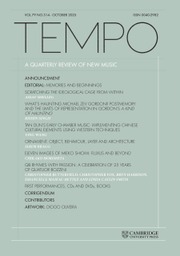There are many ways of listening, performing and thinking about music, but perhaps this journal does not always get close enough to the detail of these activities, to a moment-to-moment account of what happens as we listen, play and respond.
Two articles in this issue attempt to redress that imbalance. The first, Roderick Chadwick’s ‘Rock Forms and Avian Sequences: Performing Edward Cowie’s Cycles and Sonatas’, is a reflection on the process of learning, playing and recording some of Cowie’s recent music. Chadwick considers both practical and aesthetic questions – how to manage the flow of energy required, how to articulate the different layers within complex musical textures – and his responses to these questions are complemented by extracts from a fascinating email exchange with the composer. Elsewhere, in a profile of Chadwick, his work on Cowie’s music is put in the context of his wider career as a pianist; we also include three of the drawings that constitute an essential part of Cowie’s creative process.
Even more detailed is Timothy McCormack’s article on three works by the American composer Michelle Lou, opening, untitled three-part construction and HoneyDripper. Not only does McCormack give detailed descriptions of what happens in each of these pieces; he also describes what happens to him as he listens. This may sound like autoethnography, one of musicology’s current fads, but it isn’t: McCormack is both unflinchingly honest in recording his reactions to the music and consistently careful in locating the sound events that trigger these reactions.
Juan Parra Cancino and Neil O Connor’s articles on Éliane Radigue’s music carry on from articles by Michelle Mackenzie and Douglas Osmun in TEMPO 311. Like those previous articles, Parra Cancino and O Connor’s are based on papers first presented at the ‘Radigue at 90ʹ symposium, hosted by Columbia University’s Global Center in Paris in May 2023, and I am grateful to Luke Nickel and William Dougherty for organising the seminar and making its proceedings available to TEMPO. Although one might expect the proceedings of a symposium that celebrated many decades of a creative life to adopt a general perspective, Parra Cancino and O Connor’s articles deal with very specific aspects of her work. O Connor examines the creative exchange between Radigue and the synthesisers with which she worked, in particular the ARP 2500 with which she made Trilogie de la Mort (1988–93). Parra Cancino discusses how close engagement with the technology used in the making of a work, in this case Radigue’s Usral (1969), can facilitate both analysis and interpretation.
Radigue is a telling example of a composer whose significance within new music has been radically reappraised in the latter part of her career, and reappraisal is, perhaps, one of musicology’s most useful functions. It is also the motivation behind ‘Non Consumiamo Stockhausen’, an article which grew out of a discussion between Richard Barrett and me about our perception that interest in Stockhausen had waned among younger composers. The article takes the form of a dialogue, not only between its authors, but also between us and Stockhausen’s music, and its title echoes Luigi Nono’s 1969 work for voice and tape, Non consumiamo Marx, which in turn echoed a slogan from the uprising in Paris in 1968. Seventeen years after Stockhausen’s death, it is important to resist the tendency for listening to music to become no more than passive consumption; in our discussion, Barrett and I attempt to confront received ideas about Stockhausen’s work, in all its phases, and to think self-critically about the ways in which our own experiences of that work may have become an impediment to an active engagement with how it sounds, the patterns it makes and what those might mean.
There is also a Nono reference in Olga Neuwirth’s Le Encantadas o le Avventure nel Mare delle Meraviglie (2014–15), the subject of an article by Christoph Haffter. Le Encantadas is formed of five movements that Neuwirth calls ‘islands’, the term Nono uses for three of the sections of his Prometeo, and Haffter’s interpretation of the work focuses on a song from the fifth of these ‘isola’. It is a radical musicological response to a radical compositional decision, because this song is sung, not by a human musician, but by Hatsune Miku, a Vocaloid voicebank developed by Crypton Future Media and released in 2004; since then, the Hatsune Miku hologram has become a virtual pop star. How should we hear this synthetic intervention, asks Haffter: as negation, celebration, nostalgia or resistance? And if this seems further from Edward Cowie’s evocations of the natural world than a single TEMPO issue should properly go, I would suggest that Neuwirth’s appropriation of a virtual pop singer is, in 2024, no stranger than the instrumental transcription of birdsong.
* * *
As much as any quarterly journal can, we strive for a sense of topicality, and it has been very frustrating for Heather Roche and me that there have been such long delays in publication of the previous two issues: the July issue did not appear until late August, and the October issue did not appear until mid-December. By the time this issue of TEMPO reaches you, we hope that the after-effects of the cyberattack that Cambridge University Press suffered in June 2024 will finally have passed.



